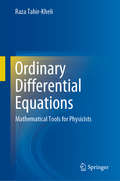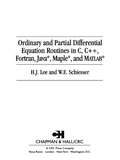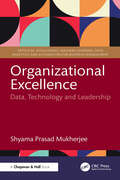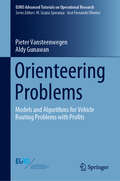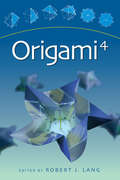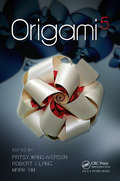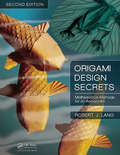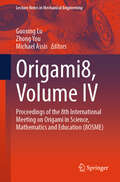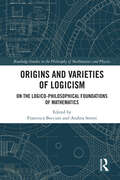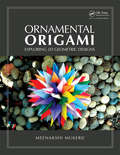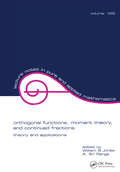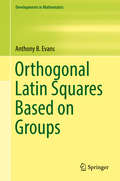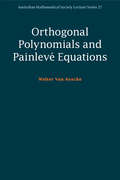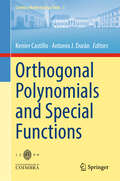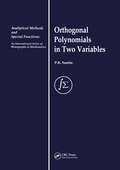- Table View
- List View
Ordinary Differential Equations: Basics and Beyond
by David G. Schaeffer John W. CainThis book develops the theory of ordinary differential equations (ODEs), starting from an introductory level (with no prior experience in ODEs assumed) through to a graduate-level treatment of the qualitative theory, including bifurcation theory (but not chaos). While proofs are rigorous, the exposition is reader-friendly, aiming for the informality of face-to-face interactions. A unique feature of this book is the integration of rigorous theory with numerous applications of scientific interest. Besides providing motivation, this synthesis clarifies the theory and enhances scientific literacy. Other features include: (i) a wealth of exercises at various levels, along with commentary that explains why they matter; (ii) figures with consistent color conventions to identify nullclines, periodic orbits, stable and unstable manifolds; and (iii) a dedicated website with software templates, problem solutions, and other resources supporting the text. Given its many applications, the book may be used comfortably in science and engineering courses as well as in mathematics courses. Its level is accessible to upper-level undergraduates but still appropriate for graduate students. The thoughtful presentation, which anticipates many confusions of beginning students, makes the book suitable for a teaching environment that emphasizes self-directed, active learning (including the so-called inverted classroom).
Ordinary Differential Equations: Introduction and Qualitative Theory, Third Edition (Chapman & Hall/CRC Pure and Applied Mathematics)
by Jane CroninDesigned for a rigorous first course in ordinary differential equations, Ordinary Differential Equations: Introduction and Qualitative Theory, Third Edition includes basic material such as the existence and properties of solutions, linear equations, autonomous equations, and stability as well as more advanced topics in periodic solutions of
Ordinary Differential Equations: Mathematical Tools For Physicists
by Raza Tahir-KheliThis textbook describes rules and procedures for the use of Differential Operators (DO) in Ordinary Differential Equations (ODE). The book provides a detailed theoretical and numerical description of ODE. It presents a large variety of ODE and the chosen groups are used to solve a host of physical problems. Solving these problems is of interest primarily to students of science, such as physics, engineering, biology and chemistry. <P><P> Scientists are greatly assisted by using the DO obeying several simple algebraic rules. The book describes these rules and, to help the reader, the vocabulary and the definitions used throughout the text are provided. A thorough description of the relatively straightforward methodology for solving ODE is given. <P><P>The book provides solutions to a large number of associated problems. ODE that are integrable, or those that have one of the two variables missing in any explicit form are also treated with solved problems. The physics and applicable mathematics are explained and many associated problems are analyzed and solved in detail. Numerical solutions are analyzed and the level of exactness obtained under various approximations is discussed in detail.
Ordinary and Partial Differential Equation Routines in C, C++, Fortran, Java, Maple, and MATLAB
by W.E. Schiesser H.J. LeeThis book provides a set of ODE/PDE integration routines in the six most widely used computer languages, enabling scientists and engineers to apply ODE/PDE analysis toward solving complex problems. This text concisely reviews integration algorithms, then analyzes the widely used Runge-Kutta method. It first presents a complete code before discussin
Organizational Excellence: Data, Technology and Leadership (Artificial Intelligence, Machine Learning, Data Analytics and Automation for Business Management)
by Shyama Prasad MukherjeeThis book discusses the multifaceted nature of organizational excellence and proceeds to consider the roles played by data, technological advances leading to innovation and value-based leadership in guiding an organization in its journey towards excellence. Moving beyond conventional growth metrics, this book presents excellence as a continuous journey of improvement, integrating data-driven decision-making, digital transformation, and value-based leadership. The book highlights the transformative role of AI and advanced digital technologies in optimizing processes, fostering innovation, and enhancing performance measurement. It also explores Six Sigma, Lean Management, reviews frameworks like Baldridge, EFQM, Excellence Canada, and other quality improvement frameworks, emphasizing the need for continuous process refinement. It is an essential resource for leaders, managers, and professionals in management, strategy, operations, and innovation, as well as scholars in management science and organizational development.This book accomplishes the following: Highlights the role of data analytics and AI in process optimization and innovation; explores the critical factors driving sustained organizational success Introduces scenario planning and robust decision-making to develop strategies Distinguishes excellence from growth and presents it as a continuous improvement journey Considers institutionalized innovation and new product development as essential Covers Six Sigma, Lean Management, and other methodologies, emphasizes governance, ethics, and corporate social responsibility
Orienteering Problems: Models and Algorithms for Vehicle Routing Problems with Profits (EURO Advanced Tutorials on Operational Research)
by Pieter Vansteenwegen Aldy GunawanThis tutorial introduces readers to several variants of routing problems with profits. In these routing problems each node has a certain profit, and not all nodes need to be visited. Since the orienteering problem (OP) is by far the most frequently studied problem in this category of routing problems, the book mainly focuses on the OP. In turn, other problems are presented as variants of the OP, focusing on the similarities and differences. The goal of the OP is to determine a subset of nodes to visit and in which order, so that the total collected profit is maximized and a given time budget is not exceeded.The book provides a comprehensive review of variants of the OP, such as the team OP, the team OP with time windows, the profitable tour problem, and the prize-collecting travelling salesperson problem. In addition, it presents mathematical models and techniques for solving these OP variants and discusses their complexity. Several simple examples and benchmark instances, together with their best-known results, are also included. Finally, the book reviews the latest applications of these problems in the fields of logistics, tourism and others.
Origametry: Mathematical Methods in Paper Folding
by Thomas C. HullOrigami, the art of paper folding, has a rich mathematical theory. Early investigations go back to at least the 1930s, but the twenty-first century has seen a remarkable blossoming of the mathematics of folding. Besides its use in describing origami and designing new models, it is also finding real-world applications from building nano-scale robots to deploying large solar arrays in space. Written by a world expert on the subject, Origametry is the first complete reference on the mathematics of origami. It brings together historical results, modern developments, and future directions into a cohesive whole. Over 180 figures illustrate the constructions described while numerous 'diversions' provide jumping-off points for readers to deepen their understanding. This book is an essential reference for researchers of origami mathematics and its applications in physics, engineering, and design. Educators, students, and enthusiasts will also find much to enjoy in this fascinating account of the mathematics of folding.
Origami 4 (AK Peters/CRC Recreational Mathematics Series)
by Robert J. LangThe connections between origami, mathematics, science, technology, and education have been a topic of considerable interest now for several decades. While many individuals have happened upon discrete connections among these fields during the twentieth century, the field really took off when previously isolated individuals began to make stronger con
Origami 5: Fifth International Meeting of Origami Science, Mathematics, and Education (AK Peters/CRC Recreational Mathematics Series)
by Robert J. Lang Patsy Wang-Iverson Mark YimOrigami5 continues in the excellent tradition of its four previous incarnations, documenting work presented at an extraordinary series of meetings that explored the connections between origami, mathematics, science, technology, education, and other academic fields.The fifth such meeting, 5OSME (July 13-17, 2010, Singapore Management University) fol
Origami Design Secrets: Mathematical Methods for an Ancient Art, Second Edition (AK Peters/CRC Recreational Mathematics Series)
by Robert J. LangThe magnum opus of one of the world's leading origami artists, the second edition of Origami Design Secrets reveals the underlying concepts of origami and how to create original origami designs. Containing step-by-step instructions for 26 models, this book is not just an origami cookbook or list of instructions-it introduces the fundamental buildin
Origami Dots: Folding paper to explore geometry
by Andy ParkinsonAll the challenges in this entertaining puzzle book are the same. Fold the corner of the paper to a given dot and find the folded area. A small move of the target dot can drastically change the logic needed to find the solution to the challenge. The problems become increasingly complex as the book progresses, with possible solutions involving Pythagoras' and similar triangles as well as trigonometry and algebra. However, insights learnt from earlier challenges can help with those that follow. If at any point the challenge becomes too great, the answers can always be found by measurement with a ruler and directly calculating the area. The book encourages curiosity, a "find out what you can" approach that creates interesting and varied solution strategies. The aim is that deep thinking and geometrical reasoning can come out of exploring and discussing the paper folds. The challenges are for all ages (10 years and over). Thus, for teachers the book provides a rich source of challenges that have a similar appearance, yet hide an obvious method and require students to choose how to approach the problem. Comparing solution methods when checking the answers is also useful as the solutions highlight some fascinating facts linked with these simple folds.
Origami Inspirations (AK Peters/CRC Recreational Mathematics Series)
by Meenakshi MukerjiThis handsome book is aimed towards those with an intermediate skill level, but the origami basics included at the start of the book make it accessible to beginners. A number of beautiful models are offered, ranging from cubes to prisms to dodecahedra. As with the author's two previous books, Origami Inspirations provides step-by-step instructions
Origami Tessellations: Awe-Inspiring Geometric Designs
by Eric GjerdeEric Gjerde demonstrates 25 of his favorite tessellations and turns them into projects for newcomers as well as experienced origamists. With step-by-step instructions, illustrated crease patterns, and how-to photos, you'll learn to create these wonderful designs yourself. Eric's first book covers the fundamentals of origami tessellations, provides history, and describes simple beginning techniques with detailed illustrations and photographs. An extensive gallery showcases tessellations folded by the world's leading origami fine artists---inspiring you to experiment, innovate, and eventually create your own unique designs.
Origami8, Volume IV: Proceedings of the 8th International Meeting on Origami in Science, Mathematics and Education (8OSME) (Lecture Notes in Mechanical Engineering)
by Zhong You Guoxing Lu Michael AssisThese four volumes of proceedings contain 126 papers contributed to the 8 th International Meeting on Origami Science, Mathematics and Education (8OSME), held on 16–18 July 2024 at Swinburne University of Technology in Melbourne, Australia. The papers represent current work in different disciplines of origami and they are grouped into four subject themes, Volume 1 - Engineering I , Volume 2 - Engineering II, Volume 3 - Mathematics, Computation, History and Mental Health, and Volume 4 - Design and Education. We witness increasing interests in origami from researchers, practitioners and artists. Of a special note is the rapidly growing research in origami engineering, a distinctive field with fundamental concepts and applications related to space, mechanical, material, medical and structural engineering etc. Participants of 8OSME should find great passion and opportunity of collaborations across disciplines of origami. We hope these four volumes will inspire not just currently active researchers and artists, but also the next generation of origami scientists, mathematicians, engineers, designers, historians, and teachers.
Origami^{3} (AK Peters/CRC Recreational Mathematics Series)
by Thomas HullThe book contains papers from the proceedings of the 3rd International Meeting of Origami Science, Math, and Education, sponsored by OrigamiUSA. They cover topics ranging from the mathematics of origami using polygon constructions and geometric projections, applications, and science of origami, and the use of origami in education.
Origins and Varieties of Logicism: On the Logico-Philosophical Foundations of Mathematics (Routledge Studies in the Philosophy of Mathematics and Physics)
by Francesca Boccuni Andrea SereniThis book offers a plurality of perspectives on the historical origins of logicism and on contemporary developments of logicist insights in philosophy of mathematics. It uniquely provides up-to-date research and novel interpretations on a variety of intertwined themes and historical figures related to different versions of logicism.The essays, written by prominent scholars, are divided into three thematic sections. Part I focuses on major authors like Frege, Dedekind, and Russell, providing a historical and theoretical exploration of such figures in the philosophical and mathematical milieu in which logicist views were first expounded. Part II sheds new light on the interconnections between these founding figures and a number of influential other traditions, represented by authors like Hilbert, Husserl, and Peano, as well as on the reconsideration of logicism by Carnap and the logical empiricists. Finally, Part III assesses the legacy of such authors and of logicist themes for contemporary philosophy of mathematics, offering new perspectives on highly debated topics—neo-logicism and its extension to accounts of ordinal numbers and set-theory, the comparison between neo-Fregean and neo-Dedekindian varieties of logicism, and the relation between logicist foundational issues and empirical research on numerical cognition—which define the prospects of logicism in the years to come.This book offers a comprehensive account of the development of logicism and its contemporary relevance for the logico-philosophical foundations of mathematics. It will be of interest to graduate students and researchers working in philosophy of mathematics, philosophy of logic, and the history of analytic philosophy.
Origins of Mathematical Words: A Comprehensive Dictionary of Latin, Greek, and Arabic Roots
by Anthony Lo BelloThe most comprehensive math root dictionary ever published.Outstanding Academic Title, ChoiceDo you ever wonder about the origins of mathematical terms such as ergodic, biholomorphic, and strophoid? Here Anthony Lo Bello explains the roots of these and better-known words like asymmetric, gradient, and average. He provides Greek, Latin, and Arabic text in its original form to enhance each explanation. This sophisticated, one-of-a-kind reference for mathematicians and word lovers is based on decades of the author's painstaking research and work.Origins of Mathematical Words supplies definitions for words such as conchoid (a shell-shaped curve derived from the Greek noun for "mussel") and zenith (Arabic for "way overhead"), as well as approximation (from the Latin proximus, meaning "nearest"). These and hundreds of other terms wait to be discovered within the pages of this mathematical and etymological treasure chest.
Orlicz Spaces and Generalized Orlicz Spaces (Lecture Notes in Mathematics #2236)
by Petteri Harjulehto Peter HästöThis book presents a systematic treatment of generalized Orlicz spaces (also known as Musielak–Orlicz spaces) with minimal assumptions on the generating Φ-function. It introduces and develops a technique centered on the use of equivalent Φ-functions. Results from classical functional analysis are presented in detail and new material is included on harmonic analysis. Extrapolation is used to prove, for example, the boundedness of Calderón–Zygmund operators. Finally, central results are provided for Sobolev spaces, including Poincaré and Sobolev–Poincaré inequalities in norm and modular forms. Primarily aimed at researchers and PhD students interested in Orlicz spaces or generalized Orlicz spaces, this book can be used as a basis for advanced graduate courses in analysis.
Ornamental Origami: Exploring 3D Geometric Designs (Ak Peters Ser.)
by Meenakshi MukerjiThis book is a great resource for people who enjoy polyhedra, symmetry, geometry, mathematics and origami. The types of models presented are similar in nature to the models in Mukerji's Marvelous Modular Origami, but some of the chapters are more advanced and all of the designs are new. The reader can learn about polyhedra while making these models and is left with the ability to design one's own models. Step-by-step folding instructions for over 40 models are presented. Although the book is for intermediate folders, beginners are encouraged to try because origami basics are explained. The diagrams are easy to follow and each model is accompanied by breathtaking finished model photographs.
Orthogonal Functions: Moment Theory and Continued Fractions
by William B. Jones; A. Sri Ranga"Oulines an array of recent work on the analytic theory and potential applications of continued fractions, linear functionals, orthogonal functions, moment theory, and integral transforms. Describes links between continued fractions. Pade approximation, special functions, and Gaussian quadrature."
Orthogonal Latin Squares Based on Groups (Developments in Mathematics #57)
by Anthony B. EvansThis monograph presents a unified exposition of latin squares and mutually orthogonal sets of latin squares based on groups. Its focus is on orthomorphisms and complete mappings of finite groups, while also offering a complete proof of the Hall–Paige conjecture. The use of latin squares in constructions of nets, affine planes, projective planes, and transversal designs also motivates this inquiry. The text begins by introducing fundamental concepts, like the tests for determining whether a latin square is based on a group, as well as orthomorphisms and complete mappings. From there, it describes the existence problem for complete mappings of groups, building up to the proof of the Hall–Paige conjecture. The third part presents a comprehensive study of orthomorphism graphs of groups, while the last part provides a discussion of Cartesian projective planes, related combinatorial structures, and a list of open problems. Expanding the author’s 1992 monograph, Orthomorphism Graphs of Groups, this book is an essential reference tool for mathematics researchers or graduate students tackling latin square problems in combinatorics. Its presentation draws on a basic understanding of finite group theory, finite field theory, linear algebra, and elementary number theory—more advanced theories are introduced in the text as needed.
Orthogonal Polynomials and Painlevé Equations
by Walter Van AsscheThere are a number of intriguing connections between Painlevé equations and orthogonal polynomials, and this book is one of the first to provide an introduction to these. Researchers in integrable systems and non-linear equations will find the many explicit examples where Painlevé equations appear in mathematical analysis very useful. Those interested in the asymptotic behavior of orthogonal polynomials will also find the description of Painlevé transcendants and their use for local analysis near certain critical points helpful to their work. Rational solutions and special function solutions of Painlevé equations are worked out in detail, with a survey of recent results and an outline of their close relationship with orthogonal polynomials. Exercises throughout the book help the reader to get to grips with the material. The author is a leading authority on orthogonal polynomials, giving this work a unique perspective on Painlevé equations.
Orthogonal Polynomials and Special Functions (Coimbra Mathematical Texts #3)
by Kenier Castillo Antonio J. DuránThe aim of this book is to honor the memory of Professor José Carlos Petronilho and hence focuses on his main research areas (Special Functions, Orthogonal Polynomials, Approximation Theory). It is a collaborative book and among the contributing authors are outstanding leaders in the field. The book addresses different topics exploring the connection between the areas already mentioned and their applications, from different perspectives and using several tools, both analytical and algebraic. Beside the researches working in these topics, the book potentially interests the readers working in areas of Mathematics, Science and Technology where Approximation Theory, Special Functions and Orthogonality are potentially useful tools.
Orthogonal Polynomials in Two Variables (Analytical Methods And Special Functions Ser.)
by P.K. SuetinPresenting a comprehensive theory of orthogonal polynomials in two real variables and properties of Fourier series in these polynomials, this volume also gives cases of orthogonality over a region and on a contour. The text includes the classification of differential equations which admits orthogonal polynomials as eigenfunctions and several two-dimensional analogies of classical orthogonal polynomials.
Orthogonal Polynomials of Several Variables
by Yuan Xu Charles F. DunklThis is the first modern book on orthogonal polynomials of several variables, which are valuable tools used in multivariate analysis, including approximations and numerical integration. The book presents the theory in elegant form and with modern concepts and notation. It introduces the general theory and emphasizes the classical types of orthogonal polynomials whose weight functions are supported on standard domains such as the cube, the simplex, the sphere and the ball. It also focuses on those of Gaussian type, for which fairly explicit formulae exist. The authors' approach blends classical analysis and symmetry-group-theoretic methods. The book will be welcomed by research mathematicians and applied scientists, including applied mathematicians, physicists, chemists and engineers.


